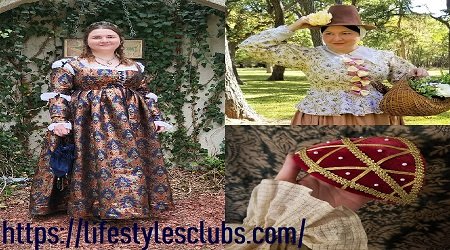Renaissance fairs transport us to an era of chivalry, art, and culture. Dressing in authentic Renaissance Fair Fashion is not just a way to enhance your experience but also a way to connect with history. Whether you’re a first-time attendee or a seasoned fairgoer, this guide will help you create the perfect look. From historical accuracy to creative interpretations, we’ll cover everything you need to know.
Table of Contents
- Introduction to Renaissance Fair Fashion
- Historical Context of Renaissance Clothing
- Dressing for Men
- Dressing for Women
- Children’s Renaissance Attire
- Essential Accessories
- DIY Costume Ideas
- Tips for Budget-Friendly Costumes
- Where to Buy Renaissance Fair Clothing
- Frequently Asked Questions
- Conclusion
- Disclaimer

1. Introduction to Renaissance Fair Fashion
Renaissance fair fashion is an art form that combines historical accuracy with creative expression. Visitors often dress in attire inspired by the Renaissance period, spanning roughly the 14th to 17th centuries. The clothing reflects the social status, occupation, and personality of the character you aim to portray.
Why Dress Up?
- Immersion: Enhance your fair experience by stepping into character.
- Community: Bond with fellow fairgoers and performers.
- Expression: Showcase your creativity and love for history.
2. Historical Context of Renaissance Clothing
Renaissance clothing varied widely depending on the region, social class, and specific time frame. The fashion of this era is characterized by its rich fabrics, intricate designs, and elaborate layers.
Key Elements of Renaissance Fashion
| Element | Description |
|---|---|
| Fabrics | Velvet, silk, wool, and linen were commonly used. |
| Colors | Bright, bold colors signified wealth, while muted tones were for peasants. |
| Accessories | Hats, gloves, and jewelry were essential for completing the look. |
| Layers | Clothing was often layered, including chemises, bodices, and outer garments. |
3. Dressing for Men
Men’s Renaissance fashion ranged from simple peasant wear to elaborate noble attire. Here’s how to achieve the perfect look based on your chosen character:
Peasant Wear
- Shirt: Loose-fitting, long-sleeved shirts made of linen or cotton.
- Pants: Simple trousers or breeches tied at the waist.
- Footwear: Leather boots or sandals.
- Accessories: Basic hats or caps.
Noble Attire
- Doublet: A fitted jacket worn over a shirt.
- Hose: Tightly fitted leg coverings.
- Cloak: Luxurious fabric, often adorned with fur or embroidery.
- Accessories: Feathered hats, jewelry, and ornate belts.

4. Dressing for Women
Women’s Renaissance fashion was characterized by its elegance and detail. The outfits varied significantly based on social status.
Peasant Wear
- Chemise: A simple underdress made of linen.
- Overdress: A sleeveless garment worn over the chemise.
- Apron: Often added for practicality.
- Accessories: Kerchiefs or simple headdresses.
Noble Attire
- Gown: A full-length dress with a fitted bodice and wide skirts.
- Corset: Used to shape the torso and emphasize the waist.
- Headwear: Elaborate headdresses, veils, or crowns.
- Jewelry: Pearls, gemstones, and gold accents.
5. Children’s Renaissance Attire
Children’s clothing often mirrored adult styles but was simpler and more practical.
Boys
- Shirt and Breeches: Basic linen or cotton pieces.
- Vest: A simple doublet-style vest.
Girls
- Chemise and Overdress: Easy-to-wear layers.
- Accessories: Small hats or flower crowns.
6. Essential Accessories
Accessories play a crucial role in completing your Renaissance look. Here are some must-haves:
| Accessory | Purpose |
| Hats | Indicates social status and adds flair. |
| Belts | Practical and decorative. |
| Jewelry | Reflects wealth and adds elegance. |
| Gloves | Common for nobles and knights. |
| Pouches | Functional and historically accurate. |
7. DIY Costume Ideas
Creating your own Renaissance fair costume can be both fun and cost-effective. Here are some ideas:
- Upcycle Old Clothes: Use oversized shirts and skirts to create peasant looks.
- Sew Your Own: Simple patterns for chemises, doublets, and cloaks are widely available.
- Accessorize: Add belts, jewelry, and hats to elevate your outfit.
8. Tips for Budget-Friendly Costumes
Attending a Renaissance fair doesn’t have to break the bank. Here are some tips:
- Thrift Stores: Look for suitable base pieces.
- Rentals: Many fairs offer costume rentals.
- Secondhand Shops: Find gently used Renaissance clothing online.
- DIY: Handmade items can save money and add a personal touch.
9. Where to Buy Renaissance Fair Clothing
If you prefer ready-made costumes, there are many places to shop:
| Store/Website | Features |
| Etsy | Handmade and custom pieces. |
| Amazon | Affordable options with fast shipping. |
| Local Costume Shops | Try items on before purchasing. |
| Renaissance Festivals | Vendors often sell high-quality attire. |
10. Frequently Asked Questions
Q1: Do I need to dress historically accurate?
Not necessarily. While historical accuracy is appreciated, creativity and comfort are equally important.
Q2: Can I mix elements from different eras?
Yes, many fairgoers enjoy blending styles for a unique look.
Q3: Are there any dress codes?
Most fairs encourage Renaissance-inspired attire but are inclusive of all creative expressions.
11. Conclusion
Renaissance fair fashion allows you to embrace history and creativity. Whether you aim for historical accuracy or add a modern twist, dressing up enhances your experience. Use this guide to plan your outfit and make the most of your fair adventure.
12. Disclaimer
This guide is for informational purposes only. While we strive for historical accuracy, Renaissance fairs often welcome creative interpretations. Always check specific fair guidelines and policies before attending.
